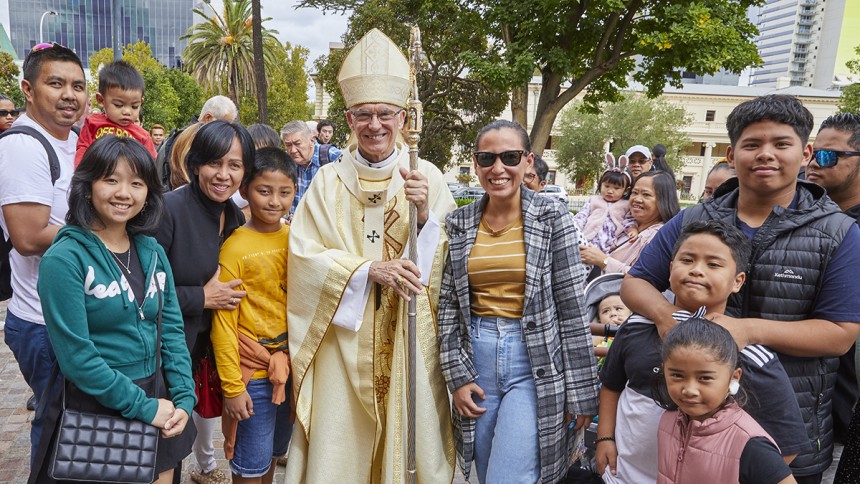
Archbishop Costelloe with members of the congregation after the 11am Mass on Easter Sunday at St Mary’s Cathedral, Sunday 9 April. Photo: Ron Tan/Archdiocese of Perth.
Perth Archbishop Timothy Costelloe SDB has this week announced the convening of a Diocesan Assembly in September this year.
Speaking in a Pastoral Letter released Tuesday 11 April, Archbishop Costelloe explained that the Assembly will consider the re-establishment of a Diocesan Pastoral Council.
Diocesan Pastoral Councils, though not mandated by the law of the Church, were are highly recommended by the Second Vatican Council.
Under the leadership of Archbishops Goody and Foley, Perth did have a Diocesan Pastoral Council for some years, but it was discontinued in the late nineties.
“Our recent Plenary Council has called for the establishment or re-establishment of such Councils in every diocese, and I believe it is appropriate for us to decide whether or not the
time is now right to make such a move,” Archbishop Costelloe explained.
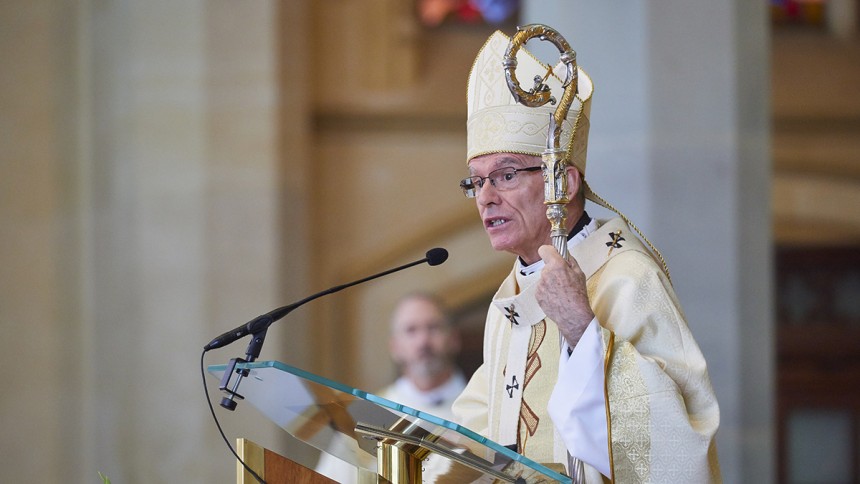
Perth Archbishop Timothy Costelloe SDB speaks during the Easter Sunday Mass, 9 April at St Mary’s Cathedral. The Archbishop has this week announced the convening of a Diocesan Assembly in September this year. Photo: Ron Tan/Archdiocese of Perth.
“It is also important to clarify why such a body might be necessary and how it should operate. The Church’s law and traditions do give some indications and establish some parameters.
“Within these, however, we have ample scope for shaping such a body according to our local needs.
“At the same time, in response to the call of Pope Francis for a more synodal Church, we might ask ourselves what a Diocesan Pastoral Council might look like it if it is a truly synodal body. These are the questions I will ask the Diocesan Assembly to consider,” he said.
The Assembly will take place on Saturday 23 September and will be held at Newman College, in Churchlands.
Former Perth Plenary Council Co-ordinator, Tony Giglia has also been appointed Co-Ordinator of the Assembly.
The convening of this Diocesan Assembly, highlighted Archbishop Costelloe, is a relatively modest initiative.
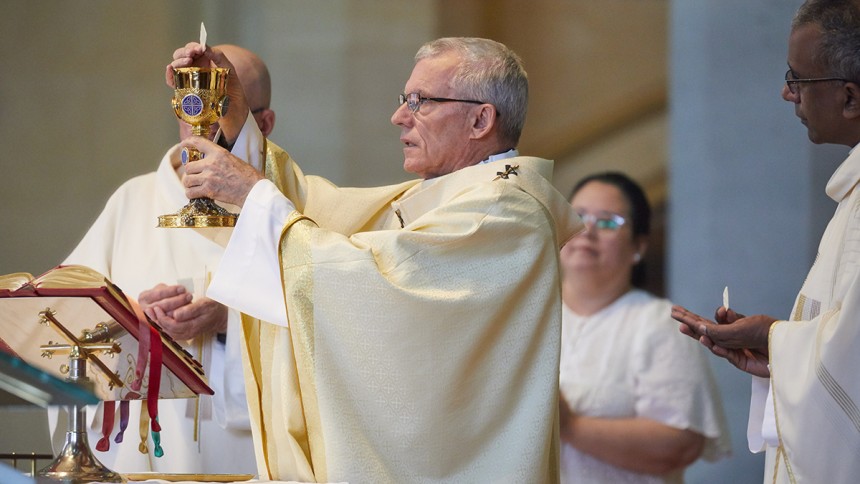
Archbishop Costelloe elevates the Body and Blood of Christ during Easter Sunday Mass, 9 April at St Mary’s Cathedral. Photo: Ron Tan/Archdiocese of Perth.
“But it is designed to set a pattern for ongoing consultation and discernment which I hope will become a permanent feature of the life of our Archdiocese in the future.
“We must continue together along the path of becoming ‘a synodal Church (which) is a listening Church, aware that listening is more than hearing. It is a reciprocal listening in which everyone has something to learn’” he said.
In an article published by the Australian Catholic Bishop’s Conference in February 2022, Historian Damian Gleeson, wrote a report on the history of diocesan pastoral councils, surveying the period since the Second Vatican Council in the 1960s.
Dr Gleeson’s report, Diocesan Pastoral Councils: An Australian Historical Study, revealed that while a significant number of archdioceses and dioceses have had pastoral councils during that time, only five were operating at the time.
The Diocese of Maitland-Newcastle had shown the longest continuous commitment to a council, stretching from 1990 until late last year.
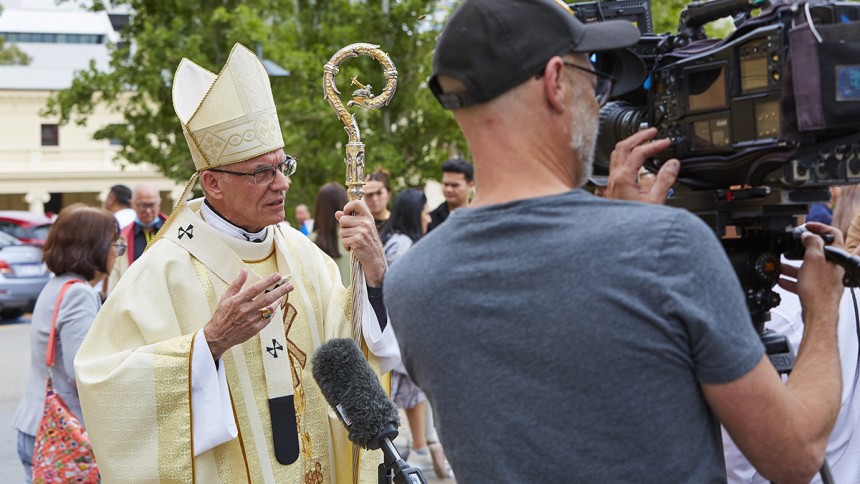
Archbishop Costelloe speaks to journalists following the 11am Mass on Easter Sunday 9 April at St Mary’s Cathedral. Photo: Ron Tan/Archdiocese of Perth.
Dr Gleeson said much was written about diocesan councils in The Light from the Southern Cross and in the Bishops Conference’s response to that report, but both seemed to underestimate their achievements while they were operating.
“Diocesan pastoral councils have generally had a solid track record of shared decision-making, respectful engagement between clergy, religious and laity by working in ‘harmony’ with the Ordinary (Bishop), and implementation of faith-focused and broad pastoral services across the Australian landscape,” he wrote.
Dr Gleeson indicated that councils flourished because of supportive bishops, effective executive committees that focused on mission to drive initiatives, strong partnerships maintained with parish and regional councils and relationships built with other diocesan organisations, as well as appropriate consultation and decision-making procedures.
The research also suggested strong achievements from councils with a majority of elected or appointed lay members.
Based on his research, Dr Gleeson drew up lists of exemplary characteristics for councils, and other attributes that contributed to their success.
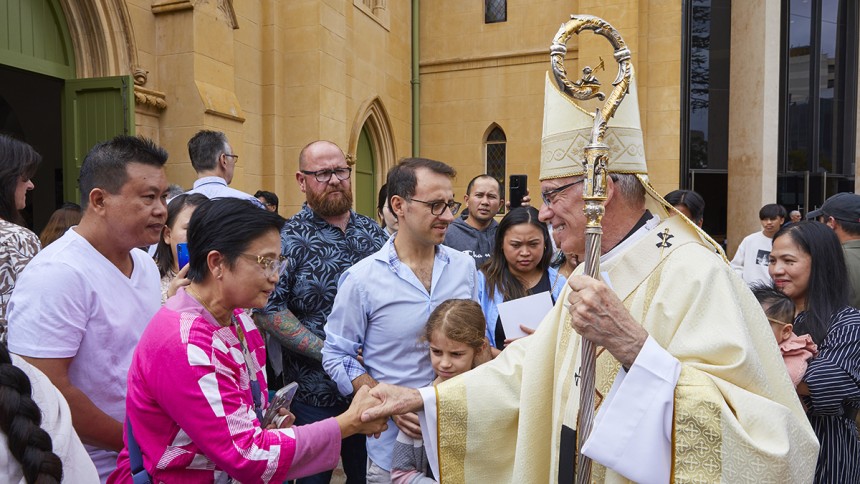
Archbishop Costelloe greets the faithful following Easter Sunday Mass, 9 April at St Mary’s Cathedral. Photo: Ron Tan/Archdiocese of Perth.
The report is available here https://ncpr.catholic.org.au/resptogovrev/
